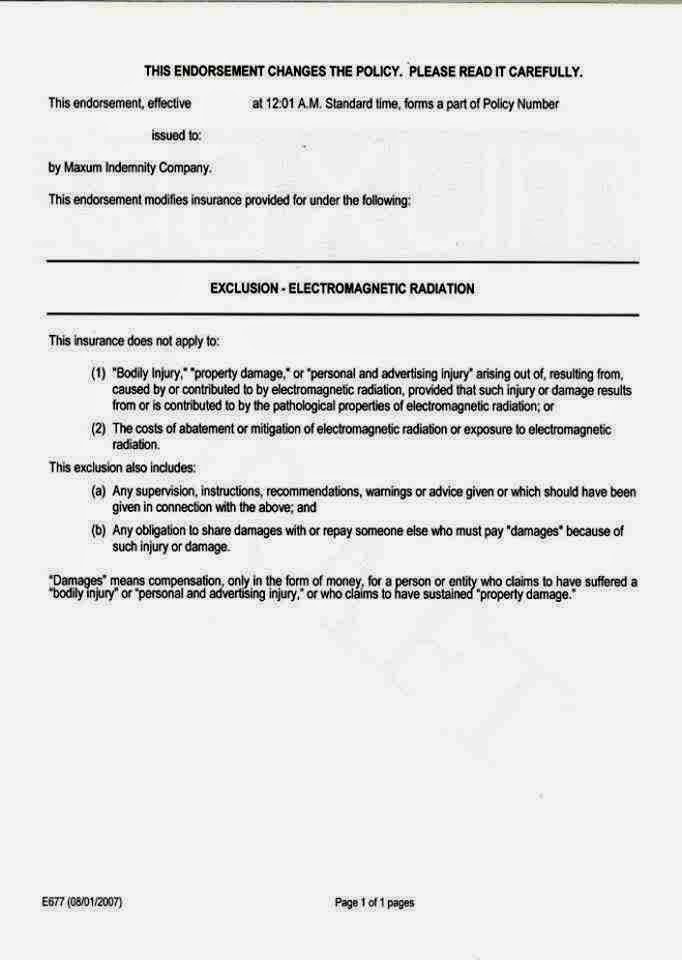FOLLOW THE MONEY – Insurance Racket Won’t Take The Bet!
Lloyd’s of London excludes coverage for RF/EMR claims – Interview With Sharon Noble – March 18th 2015

Letter to Government from Sharon Noble – Director of Coalition to Stop Smart Meters in BC
Premier Clark, Mr. Bennett and Mr. Reimer,
RE: Lloyd’s of London excludes coverage for claims caused by exposure to non-ionizing radiation.
“Based on inaccurate information provided by ITRON, Health Canada and Dr. Perry Kendall, you have been telling people that there is no health risk due to prolonged exposure to radiation from smart meters on homes and wifi in school — this despite your having received 100s of studies by independent researchers and many letters from scientists and doctors to the contrary.
“I am now forwarding information that should concern you even if the potential health problems these devices cause British Columbians doesn’t. Even though I know that the province and BC Hydro self insure their insurance coverage, I suspect you have a stop loss agreement with protection for catastrophic claims. If this stop loss agreement doesn’t already contain this waiver, soon it no doubt will exclude any claims associated with exposure to radiation from wireless devices such as cell phones, smart meters or wifi. Premier Clark, Mr. Bennett and Mr. Reimer,
“Lloyd’s of London is one of the largest insurers in the world and often leads the way in protection, taking on risks that no one else will. Attached is a recent renewal policy which, as of Feb. 7, 2015, excludes any coverage associated with exposure to non-ionizing radiation. In response to clarification, this response was received on Feb. 18, 2015 from CFC Underwriting LTD, London, UK agent for Lloyd’s:
“‘The Electromagnetic Fields Exclusion (Exclusion 32) is a General Insurance Exclusion and is applied across the market as standard. The purpose of the exclusion is to exclude cover for illnesses caused by continuous long-term non-ionising radiation exposure i.e. through mobile phone usage.”

“This means that the Province (that is we, the taxpayer) will be held liable for claims from teachers and parents of children suffering biological effects from wifi in schools, from homeowners exposed to RF from mandated smart meters on homes, and from employees forced to use cell phones or exposed to wifi at work. Lawsuits in other countries have resulted in huge payments already, and it is only a matter of time before similar lawsuits are filed and won in Canada.
“Potentially those who allow such devices, after having been fully informed about the dangers, could be held liable for negligence, and directors’ insurance may not provide financial protection. Directors’ insurance applies when people are performing their duties “in good faith”. It is hard to argue they are acting “in good faith” after having been warned by true scientific experts and by a well-respected insurer.
“Consider yourself notified once again that you could be held legally responsible for the decisions you have made.”
Yours truly,
Sharon Noble
Victoria, BC.
=============
=============
This is why in other parts of the world, companies like Telstra have taken a very proactive approach to inform millions of their customers on cell phone radiation dangers. It boils down to the cost involved to insure against health effects!
Telstra reports insurance problems over electromagnetic radiation health hazards.
Sends This Text Message to Millions Of Customers (Full Report)

Telstra has warned that insurance against any risk associated with electromagnetic radiation exposure is becoming more difficult to obtain as insurers either become less willing to provide cover or charge prohibitive prices.
Telstra acknowledged the insurance issue in the risks section of its annual report, which was released to the public. The company said “while to date we have been able to obtain limited insurance against these risks, the preparedness of insurers to give this type of insurance cover is reducing and even this limited insurance cover may not continue to be economically viable.
“There is actually a risk therefore that an actual or perceived health risk associated with mobile telecommunications equipment could:
- Lead to litigation against us;
- Adversely affect us by reducing the number or the growth rate of mobile telecommunications services or lowering usage per customer;
- Precipitate the imposition of more onerous applicable legal requirements which are more difficult or costly to comply with; or
- Hinder us in installing new mobile telecommunications equipment and facilities.
Telstra said in a section of the report dealing with information on the company’s operations that it based its position on electromagnetic energy on advice from authorities such as the Australian Radiation Protection and Nuclear Safety Agency and the World Health Organization.
The insurance debacle over radiation health hazards started over 15 years ago and wireless consumers still haven’t been informed
Insurers Balk at Risks of Phone Health Hazards
The Observer
Journalist: Sarah Ryle
April 11, 1999
Concern about the safety of mobile phones has prompted a leading Lloyd’s underwriter to refuse to insure phone manufacturers against the risk of damage to users’ health. The move comes amid mounting concern about the industry’s influence on research into the long-term effects of using a mobile. The London market provides insurance for everything from aircraft to footballers’ legs. But fears that mobile phones will be linked to illnesses such as cancer and Alzheimer’s disease have prompted John Fenn, of underwriting group Stirling, to refuse to cover manufacturers against the risk of being sued if mobiles turn out to cause long-term damage.
New research published last week by Bristol University scientist Dr. Alan Preece showed a ‘highly significant’ effect from mobile phone signals on brain function. Some previous studies linked mobiles to increased tumors in rodents, but they have been contradicted by other research. The Government has ordered the National Radiological Protection Board (NRPB) – responsible for monitoring radiation safety standards in everything from Sellafield to sunlight – to set up an independent group to identify possible areas for research. (Full Archived Story)
